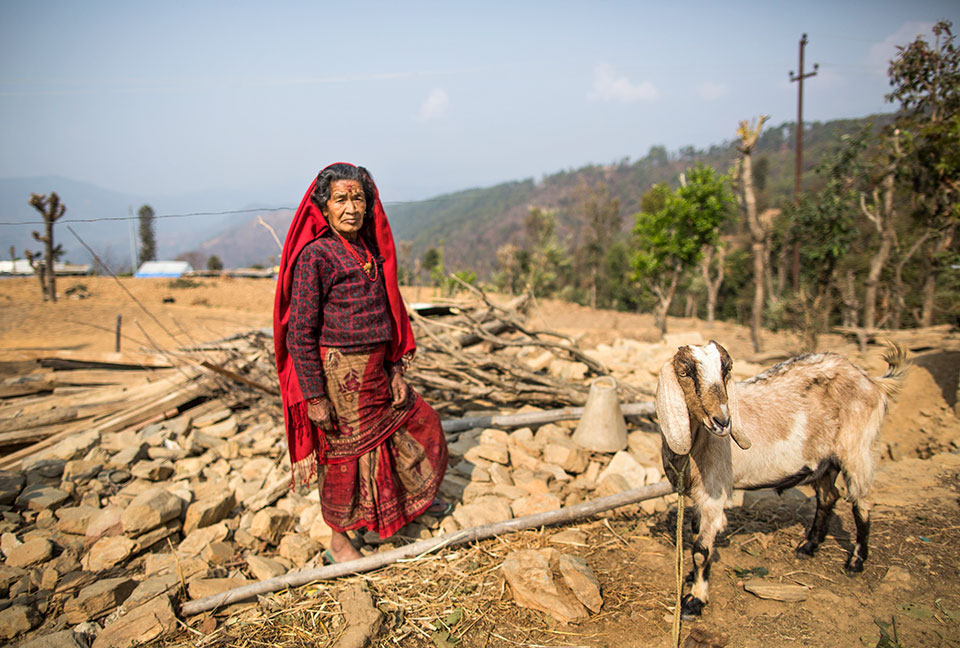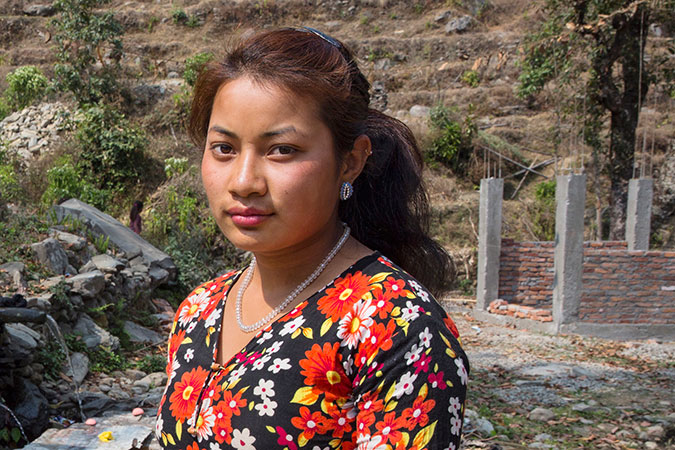Nepal: A year after the earthquakes
Date:
On 25 April 2015, a 7.8-magnitude earthquake struck Nepal, followed by another powerful 7.3-magnitude quake on 12 May. In the ongoing response to the earthquakes in Nepal, UN Women has worked side-by-side with government, UN OCHA and other UN agencies, and women’s groups to highlight the distinct needs of women and girls, and to promote their role as meaningful participants in eventual recovery, reconstruction and development. As we approach the one-year mark since the earthquakes, a spotlight on Nepali women and girls, their stories and their solutions.
Photo essay
Seventy-two year-old Bishnu Maya Dangal stands next to the pile of rubble that remains after her family home was destroyed by the April 2015 earthquake. We spend a day with her to get a glimpse into her life and the challenges she faces.
More »
Safe spaces and information centres
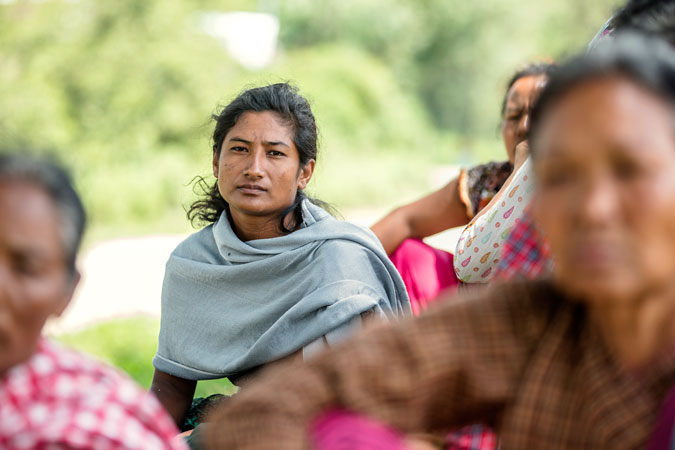
In the immediate aftermath of the earthquake, UN Women through its established partnerships with women’s groups, established five multi-purpose women’s centres, by women’s groups in collaboration with local government, and three information centres. UN Women targeted recognized groups of vulnerable women, including widows, disabled women, female household heads, Dalit women, and women with other vulnerabilities, reaching approximately 42,703 affected women so far.
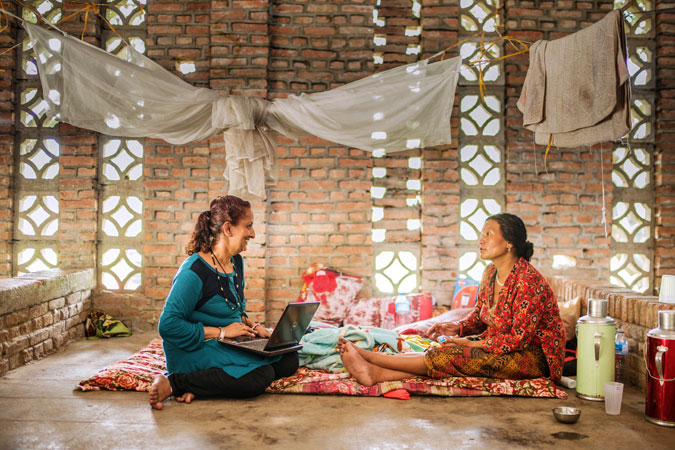
Through the five multi-purpose centres in Kavre, Sindhupalchowk, Nuwakot, Gorkha and Kathmandu districts, women were offered a range of services, including psychosocial counselling and trauma assistance (1,532 women reached), awareness-raising and information dissemination, including through messages on local radio and social mobilizers deployed in the community (with 13,966 women reached directly) on relief and recovery related activities, and referral services, such as to legal organizations to support women and girls who have experienced violence (with 618 women reached).
There has been an increase in incidents of domestic violence against women survivors [1] since the earthquake. The multi-purpose centres are safe spaces equipped with counsellors who among other things can also help survivors cope and receive support and other services.
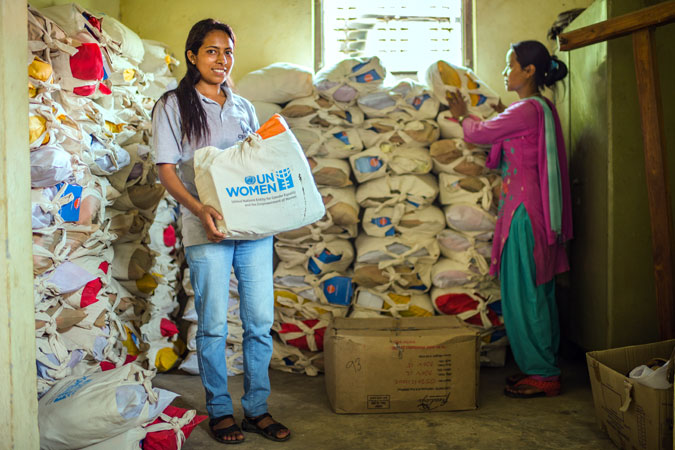
UN Women also distributed non-food items in seven districts (Kathmandu, Sindhupalchowk, Gorkha, Kavre, Nuwakot, Bhaktapur and Dhading), which included 6,513 dignity kits, 8,094 solar lanterns, 19,182 sanitary napkins and 2,500 radio sets.
Three information centres, set up in the districts of Sindhupalchowk, Gorkha and Nuwakot, have provided services to 5,262 people (4,360 women and 902 men). This includes information and linkages to relief services by government, the UN and international organizations, cash-for-work programmes, etc.
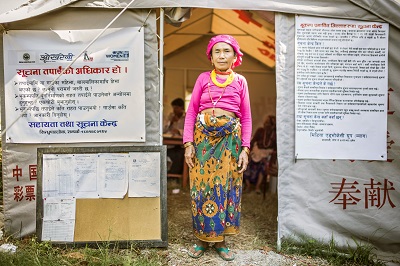
Post-earthquake, the number of migrant workers, including women, seeking to leave Nepal has been on the rise and UN Women and partners have intensified awareness programmes and economic empowerment efforts to stem the tide of women migrant workers in the affected districts.
UN Women has also called for increased participation and leadership of women and girls in the assessment, planning and implementation of the humanitarian response, offering leadership training to strengthen women’s ability to take part.
Focusing on development
As the humanitarian response shifts to focus more on development, the multi-purpose women’s centres in the three districts in the second phase of the programme, with continued support from the Government of Denmark, will aim to ensure that the local disaster preparedness and response plan respond to the needs of women and girls and strengthen their capacity to prevent, prepare for, and recover from natural hazards.
This phase of the response will also support a grass-roots women’s network for community resilience and disaster risk reduction. Also via these centres, UN Women will focus on ensuring that networks of excluded women’s in the three worst-affected districts have access to local budgets, benefit from employment opportunities and get engaged in cash-for-work programmes and livelihoods skills-enhancement in safe and supportive locations.
Gender-sensitive humanitarian planning and budgeting
“From where I stand...”
“For as long as I can remember, I have been walking miles every morning before school to fetch water for my family. Many in the village [Chilaune, near Nepal’s capital city of Kathmandu] had to walk for hours to get water for cooking and cattle. Water shortage has always been one of the biggest problems of my village. Post-earthquake, as the spouts started mysteriously drying up, the need for a solution was more urgent…”
As part of UN Women’s editorial series entitled “From where I stand”, we highlight the story of Sita Shrestha, who helped construct a tap for community water access after attending UN Women leadership training. Read more »
Women—who represent 51 per cent of the population of Nepal—have been the single-highest adversely affected group. The 14 most affected districts include about 327,000 female-headed households (26.5 per cent of all households), 40,000 women and girls with disabilities, and over 163,000 women over the age of 65. More women and girls died than men and boys, partly because of gendered roles that disproportionately assign indoor chores to women [2] and male migration out of the country [3].
Since the very outset, UN Women has been working to ensure that the humanitarian response to the earthquakes in Nepal takes the specific needs of women into account. With the National Planning Commission and Ministry of Women, Children and Social Welfare, UN Women’s technical assistance led to an engendered Post-Disaster Needs Assessment (PDNA), with a dedicated Gender Equality and Social Inclusion chapter, ensuring sectoral and recovery strategies took women’s needs into account. UN Women is also contributing to the development of the Gender Empowerment and Social Inclusion section within the Post-Disaster Recovery Framework under the leadership of the Ministry of Women, Children and Social Welfare.
With UN Women’s advocacy, the commitment to apply the Government’s Gender-Responsive Budgeting principles to all recovery and reconstruction programmes was also included in the PDNA and the Ministry of Finance requested all ministries adopt these principles in their reconstruction plans. UN Women has acted as a sector lead development partner to this end, working with the Ministry, UN and civil society partners.
High-impact partnerships
The UN Women and UN OCHA partnership has been key to ensuring that gender equality and gender mainstreaming are not neglected in humanitarian action in Nepal. Both organizations co-chaired the Humanitarian Response Inter-Cluster Gender Working Group, which continues to provide recommendations, analysis and messaging for advocacy use by the Humanitarian Country Team and Inter-Cluster Coordination, including in the humanitarian bulletins and key sectoral messages.
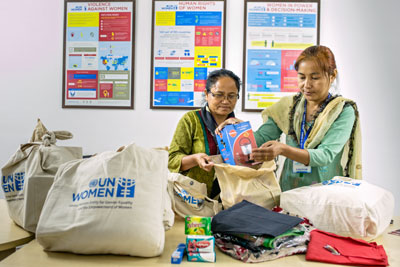
UN Women works closely with women’s groups [4], who helped assemble and distribute the dignity kits and other non-food items through the multi-purpose women’s centres, in close coordination with the national Department of Women and Children in Kathmandu and the district-level Women and Children Office. In the immediate aftermath of the earthquakes, UN Women’s NGO partner organizations also played a key role in searching the 14 most-affected districts to identify the most vulnerable women who were most in need of urgent help. They helped provide assistance, distributing urgently needed aid such as dignity kits, solar lamps and radio sets.
Over the coming year, UN Women will continue to work closely with government and development partners to support some of the most vulnerable groups of women to promote their political and economic engagement and to build their resilience.
TweetPsychosocial counselling is important to help #NepalQuake survivors overcome loss https://t.co/3t5lgATu05 pic.twitter.com/nC6V3ZNKpp
— UN Women (@UN_Women) April 1, 2016
Notes
[1] The issue of trafficking has been raised repeatedly in the UN Situation Reports. It has also been raised widely in the international media
[2] PDNA Vol. A, p. XI
[3] PDNA Vol. B, p. 229
[4] NGO partners include: Saathi, Women for Human Rights, Women’s Rehabilitation Centre, Positive Women’s Network, Home-Based Workers’ Network—SABAH, Migrant Women Workers’ Network, Rural Women’s Network, Feminist Dalit Organization, Trafficking Survivors’ Network—Shakti Samuah, and the National Disability Women’s Association.
